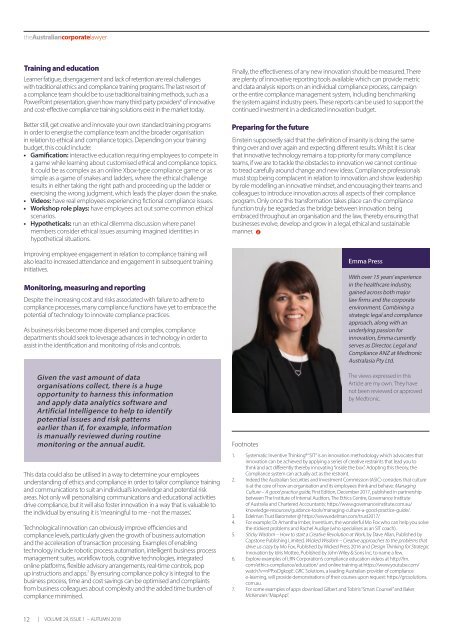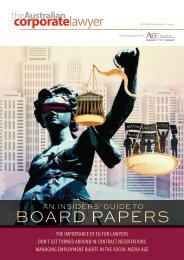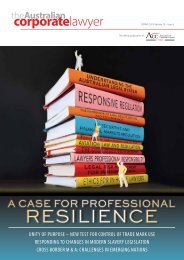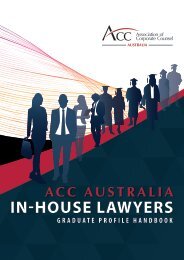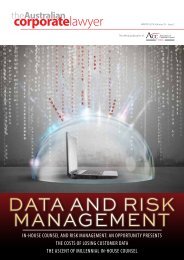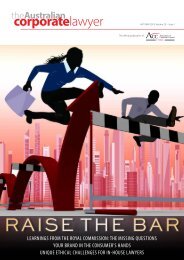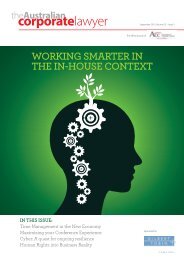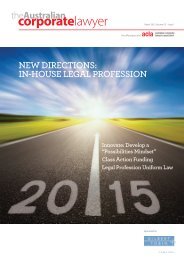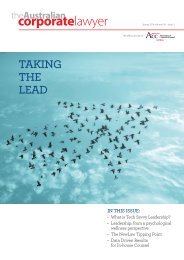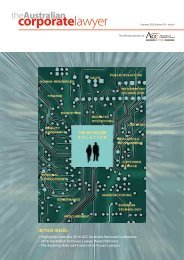Australian Corporate Lawyer - Autumn 2018
Australian Corporate Lawyer is the official publication of the Association of Corporate Counsel (ACC) Australia. The Autumn 2018 issue focuses on 'Ethics and Compliance' and features a range of articles covering topics including: can innovation and compliance co-exist? keeping the house ethically clean; and global subsidiary compliance.
Australian Corporate Lawyer is the official publication of the Association of Corporate Counsel (ACC) Australia. The Autumn 2018 issue focuses on 'Ethics and Compliance' and features a range of articles covering topics including: can innovation and compliance co-exist? keeping the house ethically clean; and global subsidiary compliance.
You also want an ePaper? Increase the reach of your titles
YUMPU automatically turns print PDFs into web optimized ePapers that Google loves.
the<strong>Australian</strong>corporatelawyer<br />
Training and education<br />
Learner fatigue, disengagement and lack of retention are real challenges<br />
with traditional ethics and compliance training programs. The last resort of<br />
a compliance team should be to use traditional training methods, such as a<br />
PowerPoint presentation, given how many third party providers 6 of innovative<br />
and cost-effective compliance training solutions exist in the market today.<br />
Better still, get creative and innovate your own standard training programs<br />
in order to energise the compliance team and the broader organisation<br />
in relation to ethical and compliance topics. Depending on your training<br />
budget, this could include:<br />
••<br />
Gamification: interactive education requiring employees to compete in<br />
a game while learning about customised ethical and compliance topics.<br />
It could be as complex as an online Xbox-type compliance game or as<br />
simple as a game of snakes and ladders, where the ethical challenge<br />
results in either taking the right path and proceeding up the ladder or<br />
exercising the wrong judgment, which leads the player down the snake.<br />
••<br />
Videos: have real employees experiencing fictional compliance issues.<br />
••<br />
Workshop role plays: have employees act out some common ethical<br />
scenarios.<br />
••<br />
Hypotheticals: run an ethical dilemma discussion where panel<br />
members consider ethical issues assuming imagined identities in<br />
hypothetical situations.<br />
Improving employee engagement in relation to compliance training will<br />
also lead to increased attendance and engagement in subsequent training<br />
initiatives.<br />
Monitoring, measuring and reporting<br />
Despite the increasing cost and risks associated with failure to adhere to<br />
compliance processes, many compliance functions have yet to embrace the<br />
potential of technology to innovate compliance practices.<br />
As business risks become more dispersed and complex, compliance<br />
departments should seek to leverage advances in technology in order to<br />
assist in the identification and monitoring of risks and controls.<br />
Given the vast amount of data<br />
organisations collect, there is a huge<br />
opportunity to harness this information<br />
and apply data analytics software and<br />
Artificial Intelligence to help to identify<br />
potential issues and risk patterns<br />
earlier than if, for example, information<br />
is manually reviewed during routine<br />
monitoring or the annual audit.<br />
This data could also be utilised in a way to determine your employees<br />
understanding of ethics and compliance in order to tailor compliance training<br />
and communications to suit an individual’s knowledge and potential risk<br />
areas. Not only will personalising communications and educational activities<br />
drive compliance, but it will also foster innovation in a way that is valuable to<br />
the individual by ensuring it is 'meaningful to me - not the masses'.<br />
Technological innovation can obviously improve efficiencies and<br />
compliance levels, particularly given the growth of business automation<br />
and the acceleration of transaction processing. Examples of enabling<br />
technology include robotic process automation, intelligent business process<br />
management suites, workflow tools, cognitive technologies, integrated<br />
online platforms, flexible advisory arrangements, real-time controls, pop<br />
up instructions and apps. 7 By ensuring compliance policy is integral to the<br />
business process, time and cost savings can be optimised and complaints<br />
from business colleagues about complexity and the added time burden of<br />
compliance minimised.<br />
Finally, the effectiveness of any new innovation should be measured. There<br />
are plenty of innovative reporting tools available which can provide metric<br />
and data analysis reports on an individual compliance process, campaign<br />
or the entire compliance management system, including benchmarking<br />
the system against industry peers. These reports can be used to support the<br />
continued investment in a dedicated innovation budget.<br />
Preparing for the future<br />
Einstein supposedly said that the definition of insanity is doing the same<br />
thing over and over again and expecting different results. Whilst it is clear<br />
that innovative technology remains a top priority for many compliance<br />
teams, if we are to tackle the obstacles to innovation we cannot continue<br />
to tread carefully around change and new ideas. Compliance professionals<br />
must stop being complacent in relation to innovation and show leadership<br />
by role modelling an innovative mindset, and encouraging their teams and<br />
colleagues to introduce innovation across all aspects of their compliance<br />
program. Only once this transformation takes place can the compliance<br />
function truly be regarded as the bridge between innovation being<br />
embraced throughout an organisation and the law, thereby ensuring that<br />
businesses evolve, develop and grow in a legal, ethical and sustainable<br />
manner. a<br />
Footnotes<br />
Emma Press<br />
With over 15 years’ experience<br />
in the healthcare industry,<br />
gained across both major<br />
law firms and the corporate<br />
environment. Combining a<br />
strategic legal and compliance<br />
approach, along with an<br />
underlying passion for<br />
innovation, Emma currently<br />
serves as Director, Legal and<br />
Compliance ANZ at Medtronic<br />
Australasia Pty Ltd.<br />
The views expressed in this<br />
Article are my own. They have<br />
not been reviewed or approved<br />
by Medtronic.<br />
1. Systematic Inventive Thinking® “SIT” is an innovation methodology which advocates that<br />
innovation can be achieved by applying a series of creative restraints that lead you to<br />
think and act differently thereby innovating “inside the box”. Adopting this theory, the<br />
Compliance system can actually act as the restraint.<br />
2. Indeed the <strong>Australian</strong> Securities and Investment Commission (ASIC) considers that culture<br />
is at the core of how an organisation and its employees think and behave: Managing<br />
Culture – A good practice guide, First Edition, December 2017, published in partnership<br />
between The Institute of Internal Auditors, The Ethics Centre, Governance Institute<br />
of Australia and Chartered Accountants; https://www.governanceinstitute.com.au/<br />
knowledge-resources/guidance-tools/managing-culture-a-good-practice-guide/.<br />
3. Edelman Trust Barometer @ https://www.edelman.com/trust2017/<br />
4. For example; Dr Amantha Imber, Inventium, the wonderful Mo Fox who can help you solve<br />
the stickiest problems and Rachel Audige (who specialises as an SIT coach).<br />
5. Sticky Wisdom – How to start a Creative Revolution at Work, by Dave Allan, Published by<br />
Capstone Publishing Limited, Wicked Wisdom – Creative approaches to the problems that<br />
drive us crazy by Mo Fox, Published by Wicked Press 2016 and Design Thinking for Strategic<br />
Innovation by Idris Mottee, Published by John Wiley & Sons Inc, to name a few.<br />
6. Explore examples of LRN Corporation’s compliance education videos at http://lrn.<br />
com/ethics-compliance/education/ and online training at https://www.youtube.com/<br />
watch?v=nPPxsDgkopE. GRC Solutions, a leading <strong>Australian</strong> provider of compliance<br />
e-learning, will provide demonstrations of their courses upon request: https://grcsolutions.<br />
com.au.<br />
7. For some examples of apps download Gilbert and Tobin’s “Smart Counsel” and Baker<br />
McKenzie’s “MapApp”.<br />
12 | VOLUME 29, ISSUE 1 – AUTUMN <strong>2018</strong>


